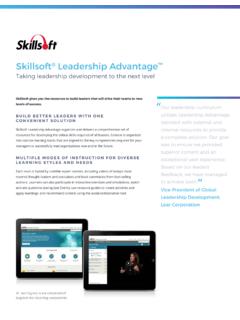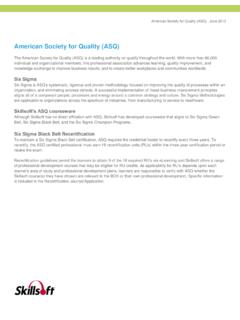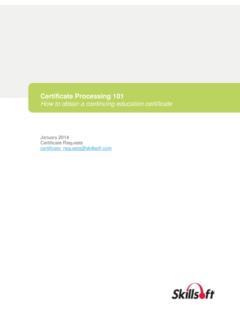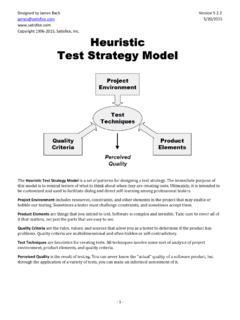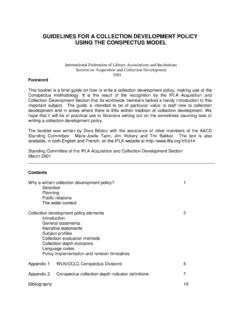Transcription of WHITE PAPER Six Elements of Effective Compliance …
1 WHITE PAPERSix Elements of Effective Compliance training :What Moves the NeedleWhite PAPER | Six Elements of Effective Compliance Training2 SHARE ONThere are six Elements to an Effective Compliance training program. This PAPER outlines these components and explores how each one contributes to organizational strategy and efficacy. The PAPER also presents the results of our Skillsoft Pulse Survey, which gathered end-user perspectives on Compliance SUMMARY WHITE PAPER | Six Elements of Effective Compliance Training3 SHARE ONThe foundation of any Effective Compliance training program begins with six essential Elements : executive commitment, accountability and ownership, training and support, end-user engagement, alignment and value measurement.
2 When all these pieces come together and work in unison, a mature and Effective culture of Compliance emerges. Organizations that establish and maintain a culture that encourages ethical conduct and a commitment to Compliance with the law, begin to meet the standards set forth in the Federal Sentencing However, just meeting the minimum requirements does not mean that a program is Effective . An organization must focus on engaging employees, educating staff and ensuring that the message behind corporate policies sets the proper expectations. When a Compliance training program becomes more than an obligation, a cultural shift occurs. An Effective Compliance program teaches employees the reasons behind the policies, provides preventative risk strategies and showcases the corrective actions that will be taken if a violation occurs.
3 With these strategies in place, organizations can then align Compliance to overall business objectives and centralize risk prevention with special attention focused on daily operations and activities. Additionally, an Effective Compliance training program calls for employees to take ownership of their actions; meaning each employee understands that he or she contributes to the program s success or failure. A global business ethics survey found that certain types of misconduct are likely to be part of a pattern of bad behavior investigating isolated incidents and taking immediate action can help prevent recurrence over Once an organization comprehends the importance of Compliance training , the question that naturally follows is how to implement a solid program and optimize it to realize the full business value such programs can provide.
4 Each of the six Elements comprises a piece of the puzzle the picture cannot be completed without every piece, each of which is equally important. Here are explanations of each of these critical components along with ways to ensure they are in place within your United States Sentencing Commission Guidelines Manual 2016. United States Sentencing Commission. November 1, 2016 Global Business Ethics Survey: Measuring Risk and Promoting Workplace Integrity. Ethics & Compliance Initiative, foundation of any Effective Compliance training program begins with six essential Elements :1. Executive commitment2. Accountability and ownership3. training and support4. End-user engagement5.
5 Alignment 6. Value measurementWhite PAPER | Six Elements of Effective Compliance Training4 SHARE ONI. EXECUTIVE COMMITMENTMany executives struggle to achieve balance, between managing staff and addressing business demands, there is a competition for their time and energy. Concerns such as fostering an ethical culture or building a culture of Compliance , can seem secondary or even tertiary to other pressing priorities. As these concerns fall to the wayside, so does Compliance training . We see large organizations every day whose Compliance programs involve nothing more than circulating policy documents to what do actual executives say about Compliance training and striving toward a more Effective program?
6 Another survey further confirmed the benefits of commitment to a strong ethical culture specifically, substantially lower rates of employee misconduct in organizations with a strong culture of Compliance (20% rate of misconduct) when compared with those organizations with weak cultures (88% rate of misconduct).3 3 National Business Ethics Survey 2013. Ethics and Compliance Initiative, 5 Full integration of Compliance and business strategyStage 1 Awareness of Compliance requirementsRules-based investmentsValues-based investmentsService & SupportStage 3 Top-down behavioral changeStage 4 Self-driven behavioral changeStage 2 Check-the-box to meet the minimal requirementsPhase 1 TrainingPhase 2 Behavior & CulturePhase 3 Strategy020406080100 WeakWeak-LeaningStrong-LeaningStrongEmpl oyees who observed misconduct in previous 12 monthsStrength of ethics cultureMisconduct Declines as Ethics Culture Improves88%59%32%20% WHITE PAPER | Six Elements of Effective Compliance Training5 SHARE ONJack J.
7 Phillips, , chairman of the ROI Institute and Patti P. Phillips, , president and CEO of the ROI Institute explain the importance of executive commitment as this: To avoid the devaluation of Compliance training and to minimize the dangers an organization can face as a result of ineffective training , it is imperative that executives fully understand the role Compliance training plays in the organization. Expectations of behavior are set at the top; without buy-in across all levels, the likelihood of a breakdown increases exponentially. To achieve executive and organizational commitment: For executives: understand the unique roles and risks throughout the organization. From there, work with General Counsel or your legal team to craft a training program that addresses these risks.
8 For managers: foster a culture that shifts the commitment from a basic check the box environment to one that fosters support from managers. Since employees interact with managers daily, managers play a huge role in the perception of Compliance programs. For employees: communicate legal requirements so that employees understand their individual obligations. Each employee should know how his or her conduct impacts business objectives and ultimately contributes to the success of the company. Furthermore, employees should feel safe to report wrongdoing without fear of Skillsoft Pulse Survey. must support Compliance in many ways. The consequences of not being in Compliance can be significant and even disastrous.
9 Executives must guarantee that Compliance programs are in place. Beyond that, they must ensure that employees know the reason for Compliance . In almost every case, there is a logical, rational, and easy to understand reason why Compliance is necessary. Executives must articulate goals of Compliance and support the processes that guarantee effectiveness. 4 WHITE PAPER | Six Elements of Effective Compliance Training6 SHARE ON Corporate policies must include mechanisms to remind employees of their unique risks, and corporate conduct standards should be embedded into employee workflow. The firm must commit to updating training materials regularly and continually assessing the program.
10 Ensure training covers all risk areas and that the organization has mechanisms in place to track any incidents that may occur. II. ACCOUNTABILITY AND OWNERSHIPThe success of any Compliance program depends on creating clear, defined levels of accountability. Senior executives must set proper expectations and include the resources and support necessary for each component of the program. For example, if an organization identifies conflicts of interest as a key risk area, then the company must allocate adequate resources and budget to create and support the training program. An organization must define the risks, program goals and level of ownership each participant will take. For Compliance training to succeed, someone must be responsible for measuring and monitoring overall program health and organizational impact.
